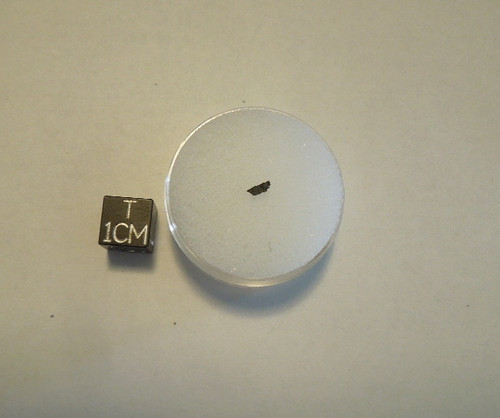Allende is one of the most famous of all witnessed falls and no collection is complete with an example of it. Until the fall of Allende, carbonaceous CV-type meteorites were extremely rare and were present only in large museums or the in the cabinets of wealthy collectors. But all of that changed on February 8, 1969 when a few thousand fragile black stones rained down on the Mexican countryside around Pueblito de Allende in Chihuahua province Mexico. During this single fall, more CV3 meteorites fell to Earth than all of the previous ones in history put together. Suddenly, this super rare carbonaceous type meteorite was available to average collectors. Allende is a Vigarano-type carbonaceous chondrite - it is also a witnessed fall and a hammer fall. This meteorite has a characteristic black matrix with light colored chondrules and white CAI's. (Calcium Aluminum Inclusions - the oldest matter in the solar system).
Refer to the photo. The black centimeter cube is shown for scale and is not included. You will get a small fragment like the one shown. Your specimen will include a labeled gemjar for safe storage.
From the Meteoritical Bulletin Entry on Allende :
Name: PUEBLITO DE ALLENDE.
The place of fall or discovery: The village of Pueblito de Allende, Chihuahua, Mexico; φ = 26958'N, λ = 105°19'W.
Date of fall or discovery: FALL, February 8, 1969, 7h05mGMT.
Class and type: STONY, carbonaceous chondrite, type III.
Number of individual specimens: METEORITE SHOWER, several dozen were collected.
Total weight: Over 100 kg.
Circumstances of the fall or discovery: The huge fireball lighted up thousands of square miles of Northern Mexico and Southwestern United States. The fireball travelled from south to north. A meteorite shower spread over 50 square kilometers area. There are several pits; the biggest one is 60 cm across and 15 cm deep. Search and preliminary investigation of the meteorites were carried out by Dr. E. King (NASA), Drs. B. Mason and R. Clarke (Smithsonian Institution, Washington, USA) and others.





